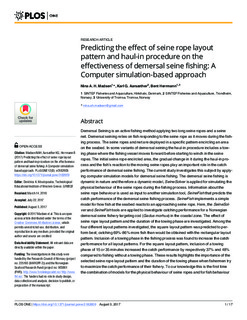| dc.contributor.author | Madsen, Nina | |
| dc.contributor.author | Aarsæther, Karl Gunnar | |
| dc.contributor.author | Herrmann, Bent | |
| dc.date.accessioned | 2017-11-16T19:08:30Z | |
| dc.date.available | 2017-11-16T19:08:30Z | |
| dc.date.created | 2017-11-14T15:46:35Z | |
| dc.date.issued | 2017-08-03 | |
| dc.identifier.citation | PLoS ONE. 2017, 12 (8:e0182609), 1-17. | nb_NO |
| dc.identifier.issn | 1932-6203 | |
| dc.identifier.uri | http://hdl.handle.net/11250/2466749 | |
| dc.description.abstract | Demersal Seining is an active fishing method applying two long seine ropes and a seine net. Demersal seining relies on fish responding to the seine rope as it moves during the fishing process. The seine ropes and net are deployed in a specific pattern encircling an area on the seabed. In some variants of demersal seining the haul-in procedure includes a towing phase where the fishing vessel moves forward before starting to winch in the seine ropes. The initial seine rope encircled area, the gradual change in it during the haul-in process and the fish's reaction to the moving seine ropes play an important role in the catch performance of demersal seine fishing. The current study investigates this subject by applying computer simulation models for demersal seine fishing. The demersal seine fishing is dynamic in nature and therefore a dynamic model, SeineSolver is applied for simulating the physical behaviour of the seine ropes during the fishing process. Information about the seine rope behaviour is used as input to another simulation tool, SeineFish that predicts the catch performance of the demersal seine fishing process. SeineFish implements a simple model for how fish at the seabed reacts to an approaching seine rope. Here, the SeineSolver and SeineFish tools are applied to investigate catching performance for a Norwegian demersal seine fishery targeting cod (Gadus morhua) in the coastal zone. The effect of seine rope layout pattern and the duration of the towing phase are investigated. Among the four different layout patterns investigated, the square layout pattern was predicted to perform best; catching 69%-86% more fish than would be obtained with the rectangular layout pattern. Inclusion of a towing phase in the fishing process was found to increase the catch performance for all layout patterns. For the square layout pattern, inclusion of a towing phase of 15 or 35 minutes increased the catch performance by respectively 37% and 48% compared to fishing without a towing phase. These results highlights the importance of the selected seine rope layout pattern and the duration of the towing phase when fishermen try to maximize the catch performance of their fishery. To our knowledge this is the first time the combination of models for the physical behaviour of seine ropes and for fish behaviour in response to seine rope movements have been applied to predict catch performance for demersal seining. | nb_NO |
| dc.language.iso | eng | nb_NO |
| dc.rights | Navngivelse 4.0 Internasjonal | * |
| dc.rights.uri | http://creativecommons.org/licenses/by/4.0/deed.no | * |
| dc.title | Predicting the effect of seine rope layout pattern and haul-in procedure on the effectiveness of demersal seine fishing: a computer simulation-based approach | nb_NO |
| dc.type | Journal article | nb_NO |
| dc.type | Peer reviewed | nb_NO |
| dc.description.version | publishedVersion | nb_NO |
| dc.rights.holder | Copyright: © 2017 Madsen et al. This is an open access article distributed under the terms of the Creative Commons Attribution License, which permits unrestricted use, distribution, and reproduction in any medium, provided the original author and source are credited. | nb_NO |
| dc.source.pagenumber | 1-17 | nb_NO |
| dc.source.volume | 12 | nb_NO |
| dc.source.journal | PLoS ONE | nb_NO |
| dc.source.issue | 8:e0182609 | nb_NO |
| dc.identifier.doi | 10.1371/journal.pone.0182609 | |
| dc.identifier.cristin | 1514129 | |
| cristin.unitcode | 7566,2,0,0 | |
| cristin.unitname | Fiskeriteknologi | |
| cristin.ispublished | true | |
| cristin.fulltext | original | |
| cristin.qualitycode | 1 | |

